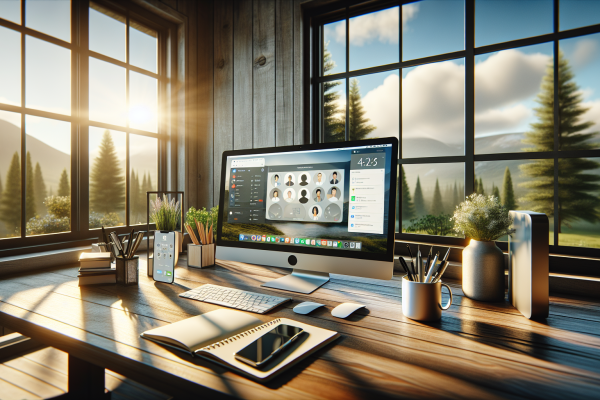Amidst an age characterised by interconnectivity and mobility, the notion of labour has experienced a profound metamorphosis. The rapid surge of remote work, which had been gaining momentum prior, was expedited by the COVID-19 pandemic. As the traditional confines of office spaces dissolve into obscurity and remote work assumes its new normative status, many individuals are now pondering the prospect of a secondary abode meticulously chosen to complement their remote work-centric lifestyle, addressing questions such as “How to buy a second home.” In this discourse, we delve into the remote work revolution and furnish counsel on the selection of an ideal secondary domicile aimed at optimising productivity and fostering equilibrium between work and life.
- The Ascension of Remote Labour
Once regarded as a privilege accorded to a privileged few, remote work has now become a ubiquitous reality for myriad individuals worldwide. The amalgamation of technological progressions with evolving work philosophies has not only rendered remote work feasible but frequently preferable. Corporations are increasingly endorsing remote work, recognizing its potential to expand the talent pool, reduce overhead expenditures, and cultivate an enhanced equilibrium between work and life for their employees.
- The Merits of a Secondary Residence for Remote Employment
While remote work endows the freedom to work from any locale graced with aninternet conduit, it simultaneously begets an inquiry: Where should one conduct their toil? This is where the notion of a secondary dwelling assumes significance. Possessing a designated sphere removed from one’s primary habitation can yield multifarious advantages:
2.1. Augmented Productivity: A consecrated workspace within one’s secondary domicile can serve as a bastion of concentration and a bulwark against distractions.
2.2. Enhanced Work-Life Equilibrium: The demarcation between work and personal life becomes more conspicuous when one possesses a secondary abode, facilitating a physical disconnection from labour at day’s end.
2.3. Heightened Well-Being: Opting for a secondary residence nestled within an environment congruous with one’s lifestyle and predilections can profoundly ameliorate overall well-being.
- Culling the Perfect Locale
The judicious selection of a secondary abode hinges upon several considerations:
3.1. Proximity to Nature: If one esteems outdoor activities or seeks a serene ambience, the choice of locale ought to gravitate toward proximity to parks, beaches, or mountainous regions. Close proximity to the bounties of nature has the capacity to invigorate the intellect and stoke the fires of creativity.
3.2. Accessibility: Ensuring facile accessibility between one’s primary residence and the secondary abode is of paramount importance, particularly when frequent travel between the two is contemplated.
3.3. Internet Connectivity: A dependable internet connection is a non-negotiable prerequisite for remote work. It is incumbent upon one to investigate the availability of high-speed internet in the prospective locality prior to arriving at a decision.
3.4. Cost of Living: Scrutinising the cost of living in the chosen locale, encompassing accommodation, sustenance, and utilities, is imperative. Opting for a more economical secondary residence can result in substantial savings.
- Conceiving Your Remote Work Sanctuary
Upon the selection of a locale, the time is ripe to devise one’s secondary residence with the exigencies of remote work in mind:
4.1. Dedicated Workspace: The establishment of a dedicated office milieu, replete with an ergonomic desk, a comfortable chair, and ample illumination, is instrumental in preserving an aura of professionalism.
4.2. Natural Illumination: The strategic positioning of one’s workspace in close proximity to a window serves to maximise exposure to natural light. Sufficient lighting is indispensable for mitigating ocular fatigue and uplifting one’s spirits.
4.3. Ergonomic Deliberations: Investment in ergonomic furnishings and accessories is warranted to ensure the creation of a comfortable and salubrious work environment.
4.4. Minimised Distractions: Crafting a workspace devoid of clutter serves to mitigate distractions. Personal effects and non-work-related paraphernalia should be stowed out of sight.
- Balancing Toil and Leisure
One of the quandaries intrinsic to remote work is the quest for equilibrium between work and leisure within one’s secondary abode. The ensuing recommendations may prove invaluable:
5.1. Establishing Boundaries: The demarcation of perspicuous boundaries between working hours and personal leisure is imperative. Adherence to a structured schedule obviates the perils of overexertion.
5.2. Erecting Leisure Precincts: The allocation of distinct sectors within one’s secondary residence earmarked for relaxation and recreational pursuits can facilitate a seamless transition from work mode to leisurely repose.
5.3. Exploration of Vicinal Amenities: Leveraging the proximate amenities, such as eateries, fitness centres, and cultural attractions, can augment one’s off-duty hours with enriching experiences.
- Sustaining the Ties with the Primary Residence
The maintenance of a secondary domicile should not entail a disconnection from one’s primary abode. The ensuing strategies foster connectivity:
6.1. Remote Surveillance Systems: The installation of remote security systems for the vigilance of one’s primary residence whilst absent is imperative. Smart technology confers the ability to monitor one’s property from the vantage of the secondary domicile.
6.2. Mail and Utility Facilitation: The arrangement for mail redirection and the automation of utility payments assures the seamless functioning of one’s primary abode in one’s absence.
- Legal and Fiscal Contemplations
Before embarking upon the voyage of remote work within the precincts of a secondary residence, it is incumbent upon one to solicit the counsel of legal and financial experts in order to address the ensuing considerations:
7.1. Tax Implications: A comprehensive comprehension of the fiscal ramifications of secondary property ownership, encompassing property taxes, income tax obligations, and conceivable deductions, is requisite.
7.2. Insurance Coverage: The verification of insurance policies to ascertain their encompassment of both primary and secondary residences, along with addressing any liability concerns, is imperative.
7.3. Property Administration: The deliberation of engaging a property management entity to oversee maintenance, repairs, and other property-related responsibilities warrants due consideration.
- Embracing the Revolution of Remote Employment
The revolution of remote work has granted us the liberty to redefine the parameters of when and where we labour. The selection of a secondary domicile for remote work transcends the realms of mere pragmatism; it presents an occasion to enrich one’s lifestyle, well-being, and productivity. By judiciously selecting the locale, configuring an appropriate workspace, and striking a harmony between toil and leisure, one can wholeheartedly embrace the advantages of remote work and partake in the best of both worlds. Thus, take the plunge and embark on a voyage of remote work that empowers one to toil, exist, and thrive on one’s own terms.





